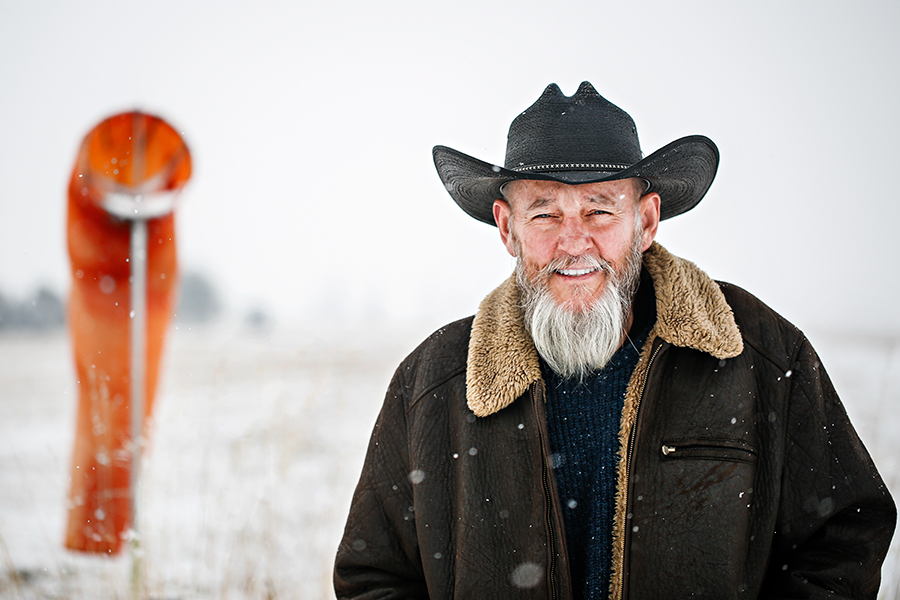A Bush Pilot’s Pandemic Shift
Local aerial photographer and bush pilot Zedekiah Morse recently launched a new photo book, gallery site and an art installation at Glacier Jet Center
By Maggie Dresser
About 10 years ago, local aerial photographer and bush pilot Zedekiah Morse was given a GoPro for Christmas. He already had a camera company at the time and had no interest in shooting photography from his airplane, but he tried it out anyway and was immediately hooked, buying several more cameras a week later.
As a lifelong pilot with a background in music production and film, it wasn’t until that moment that Morse thought seriously about shooting from his bush plane.
In 2011, Morse moved to Kalispell permanently and started investing all of his energy into aerial photography. Now, his blue, 1975 bush plane named Bluebird is equipped with 12 mounted cameras, and he’s removed the passenger seat to fit his camera equipment, power supplies and survival gear.
The Tennessee native’s combined passions for wilderness and flying have inspired him to show audiences the places he explores in the sky, while drawing awareness.
“I realize a lot of young people don’t get to see this stuff,” Morse said. “Back in 2008, I watched what was going on in Badger-Two Medicine … and I realized that if people don’t know about wilderness and if they don’t know these places exist, then how are we going to protect them?”
For the past eight years, Morse has been working on his film project, “Where Eagles Fly,” a series of eight 40-minute films ranging from reels of Glacier National Park to the Appalachian Mountains, which he planned to show in IMAX theatres. However, COVID had other plans.
Last February, Morse was days away from receiving the first check for the IMAX films when the pandemic hit. He also had a gallery planned at The Rio in Las Vegas, along with the company that was about to fund “Where Eagles Fly.” Both companies are now shut down.
“It was disastrous,” Morse said.
Since the pandemic crushed Morse’s IMAX and gallery plans, he has since shifted his operations. Instead of a gallery in Las Vegas, he now has a photo installation at the Glacier Jet Center at Glacier Park International Airport, which he says sees a higher volume of potential-buyer traffic than his gallery probably would have.
Morse also has texturized photos featured in the gallery, a relatively new 3-dimensional print technology made of polycarbonate material, which he calls “volumetric prints” that he spent three months learning how to do in Las Vegas prior to the pandemic.
Sitting on the coffee table in the airport lobby is another one of Morse’s projects. He recently launched a photo book with images he’s shot from his bush plane from all over the country. In an age when creativity and adaptability are crucial to business, Morse has also come up with a new way to market the book by selling it to realtors who personalize the front page to use as a closing gift to clients.
With the book sales, Morse is hoping to generate enough revenue to pay for “Where Eagles Fly,” which he’s trying to shift to a streaming production.
“I’m going to try to do my production 100% in house,” he said.
While Morse spent 30 years in the music industry with a background as a classically trained pianist, his work ranges from production to developing techno trailer music for films, which he still dabbles in.
“I was deeply involved in the development of techno music,” Morse said. “I was a remix artist starting in 1979 and my first job was doing remixes of Donna Summer’s ‘Love to Love You Baby.’”
“I got really into dance music, which is really funny considering I can’t dance,” he added. “I’m not just an old hillbilly.”
In the meantime, while Morse is working to get his streaming production going, he’s also building a new airplane with 10 8K resolution cameras, which will be mounted on the wing tips for a 720-degree coaxial view. He hopes to eventually dabble in Experiential Reality (XR) film, a new type of augmented, virtual reality film.
While the pandemic threw a wrench in Morse’s plans, he’s adapting so he can continue shooting 3,500 feet above mountain peaks in his plane, and his main goal is to continue showing audiences the importance of wilderness through film.
“I’m trying to raise awareness for our wilderness,” Morse said.
For more information, visit whereeaglesfly.tv.